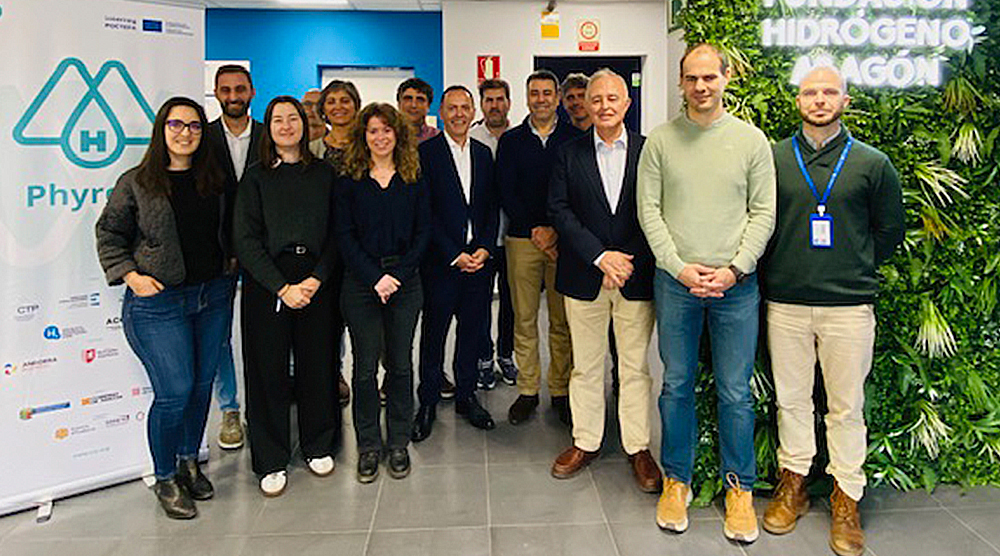More than 800 companies and research centres from Spain, France and Andorra, participating in 280 projects, demonstrate the Pyrenean region’s capacity to boost the hydrogen economy. The result is a complete overview of the sector, available on the Hydrogen Geoportal — a tool designed to facilitate connections between the economic and social sectors involved in its development. This cross-border geovisual platform — which strengthens the Pyrenean region’s position as a European benchmark in renewable hydrogen promotion — is part of the PHYRENE project, funded by the European Union (through the European Regional Development Fund – ERDF) under the Interreg POCTEFA programme.
“This pioneering tool allows us to identify which companies are working with renewable hydrogen, where they are located, which projects they are developing, and which public institutions and research agents are supporting the growth of this energy vector,” explained Idoia Arauzo, coordinator of the Development and Dynamisation Unit (UD2) of the Working Community of the Pyrenees (CTP), the entity leading the project. Arauzo emphasised that “this map is a starting point for cross-border development strategies and collaboration around the renewable hydrogen economy.” The initiative brings together eight partner entities: the CTP and energy representatives from the seven cross-border territories.
Meeting of partner entities
The Hydrogen Geoportal was presented during the meeting of the PHYRENE project partners, held on 28 and 29 October at the headquarters of the Fundación Hidrógeno Aragón (Huesca). Participants included, in addition to the foundation itself, the Comunitat de Treball dels Pirineus (CTP); the Ente Vasco de la Energía (EVE); the Government of Navarra; the Agency for Business Competitiveness (ACCIÓ) of the Government of Catalonia; Andorra Desenvolupament i Inversió – Andorra Business; the Conseil Régional d’Occitanie; and the Conseil Régional de Nouvelle-Aquitaine.
During the meeting, the partner entities highlighted the importance of continuing to make progress on the shared objectives that unite these regions on their path towards the energy transition. They also defined the next strategic and operational steps to promote the cross-border development of the renewable hydrogen economy and consolidate the Pyrenean region as a European leader in this field. “The next step is to develop the hydrogen economy in the Pyrenees, now that we know which stakeholders are involved and what infrastructure exists. From here, decisions can be made based on existing connections and the capacities of neighbouring territories,” noted the coordinator of the CTP’s Development and Dynamisation Unit.
Economic, institutional and academic support
The hydrogen map identifies 599 companies, 114 knowledge agents, and 129 institutions linked to the deployment of the hydrogen value chain (production, storage and transport of this energy source). These include public administrations, multinational companies, SMEs, universities, research centres and business associations, along with other key stakeholders.
The geoportal currently lists 278 active projects, covering initiatives dedicated to the production, storage, transformation and transport of renewable hydrogen. By territory, Andorra has 1 project (and 2 proposals under study); Aragón 51; Catalonia 95; the Basque Country 81; Navarra 12; Nouvelle-Aquitaine 22; and Occitanie 16.
Reducing the Pyrenees’ vulnerability
The PHYRENE project was launched in January 2024 with the goal of promoting the use of renewable hydrogen as a means to store and transport renewable energy and reduce the Pyrenees’ vulnerability to climate change by boosting the hydrogen economy. The initiative has a budget of €1.2 million (64% funded by the European Union through the Interreg VI-A Spain-France-Andorra POCTEFA 2021-2027 programme) and will run until the end of 2026. The aim of POCTEFA is to strengthen the economic and social integration of the Spain-France-Andorra border area.
Among the actions to be carried out are the identification and promotion of business, research and institutional synergies; establishing strategic and operational foundations for the cross-border development of the renewable hydrogen economy; and positioning the Pyrenean region as a European benchmark in this field. It is worth remembering that green hydrogen is produced exclusively using renewable energy sources.
Wednesday, 29 October 2025

